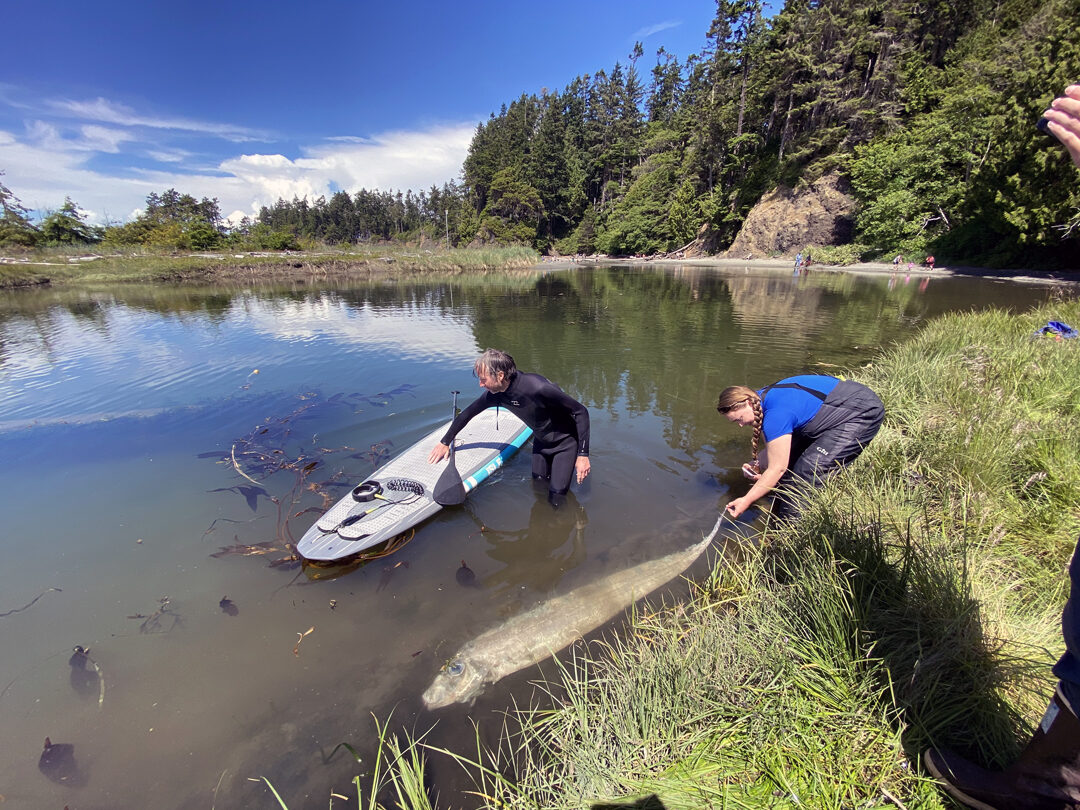
© Courtesy Harbor WildWatchOarfish
During one of many beach walks in recent months,
Harbor WildWatch of Gig Harbor was treated to the discovery of a rare species of fish known as King-of-the-Salmon, found by a paddleboarder at Salt Creek Recreation Area near Port Angeles.
The small team, who work during low tides, left very early on the morning of June 7 to explore somewhere new. For several months, the beach walks have been streamed and made virtual as a part of Harbor Wildwatch's online offerings in light of COVID-19. Met with a perfect weather day, the group spent more than five hours exploring the area in and around Tongue Point, checking out marine animals and taping vignettes for their
Facebook and
Insta pages.
As the day was winding down, exhausted and ready for the drive back to headquarters, paddleboarder Scott Herning called out to the group, "Are you biologists?" after coming upon a very large dead creature with a huge eye. Rachel Easton, biologist and education director at Harbor WildWatch, described the experience as a biologist's dream come true: "No matter how tired we were, that's definitely something we want to see!"
The fish found on June 7 measured 53 inches in length, but the species is known to grow to 6 ½ feet long and stays
primarily in deep ocean areas. Only five have been recorded as washing up on the shore between British Columbia and Washington.
"The species does eat close to shore. That's where a lot of their food is, like krill, shrimp, and small squid," Easton said. "They're solitary and few and far between. It's just chance if you come across one."
The crew excitedly worked with Herning, who waded through the 10 feet of water in his wetsuit to retrieve the fish and gently bring it ashore. At first impression the group thought it was an Oarfish, due to its long, ribbon-like appearance.
After closer inspection and the input of PLU professor and leader of Harbor WildWatch's Community Science Program, Dr. Mike Behrens, the fish was identified via video phone call as the
Trachipterus altivelis, or King-of-the-Salmon.
The name King-of-the-Salmon derives from a people known as the Makah, who dwelled near the Strait of Juan de Fuca. Ancient lore suggests the large species would lead the salmon as they returned to their spawning ground. Fishing or eating them was forbidden, as legend claims it would disrupt the salmon run.
Due to its much smaller 3-inch-wide fin and long body, it is suspected the fish may have been tumbled by waves, or currents, which pushed it into the creek area at Tongue Point where the freshwater kept it preserved. The Harbor WildWatch team documented the find with the Washington Department of Fish and Wildlife.
Harbor Wildwatch is a nonprofit organization that will soon reopen, continuing to offer many free programs, camps, and exploratory beach walks. The staff is passionate about what they do, Easton said. "When you find something cool like this, the only thing to do is share it and learn more about it. Hopefully that translates into a greater appreciation, and motivation to take care of it. We want people to take care of these bodies of water, so we can continue to see all the diversity."

Comment: Also pertinent: Creatures from the deep signal major Earth Changes: Is anyone paying attention?